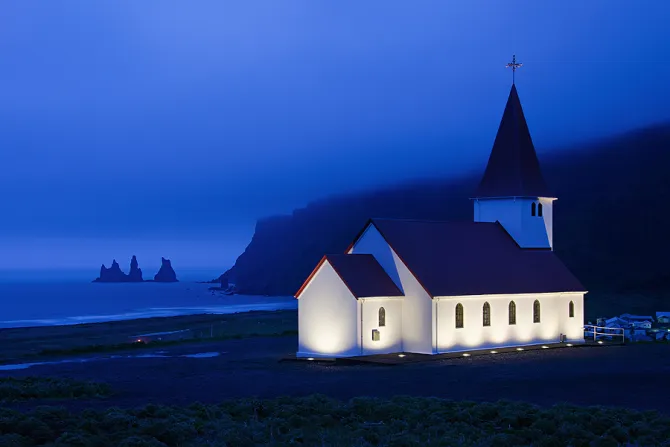The beginnings of Catholicism in Iceland
It's difficult to pinpoint exactly when Catholicism reached 65 degrees north latitude, though it seems to have gained the most traction starting around the 9th century. At that time, the first Norsemen travelled across the Norwegian sea to Iceland, where they encountered some Gaelic monks. While the Irish monks disappeared soon after, they were replaced by missionaries from Norway and northern Germany, who began baptizing a significant portion of the population.
In the late 10th and early 11th century, the number of Christians became so great that the government worried about the peace and unity of the country, whose official religion was Norse paganism.
In the year 1,000, the country's Parliament assembled to discuss the issue. The law speaker at the time, Þorgeir Þorkelsson Ljósvetningagoði (in English, Thorgeir Thorkelsson), was himself a pagan chieftain and had a tough decision before him.
According to legend, Ljósvetningagoði spent a day and a night discerning his decision under a fur blanket, and the next day declared Christianity (the reformation hadn't happened yet) as the state religion.
After his decision, Ljósvetningagoði personally converted to Christianity, and allegedly threw his pagan idols into a waterfall, which since that time became known as Goðafoss, the "waterfall of the gods" located in north-central Iceland.

Northern Lights over Reykjanes Peninsula Sea Stacks, Iceland. Credit: Diana Robinson via Flickr (CC BY-ND 2.0)
St. Thorlak
Catholicism flourished in Iceland throughout the 10th, 11th and 12th centuries. Several monasteries and convents, largely Benedictine or Augustinian in rule, sprang up throughout the country, establishing schools and heavily influencing the culture at the time.
Around 1200, the country's population was about 80,000, with 220 churches and 290 priests.
One of the most influential bishops at the time was Þorlákur Þórhallsson (or Thorlak Thorhallsson).
Born in 1133 to poor farmers, Thorlak displayed talents early on in life, urging his parents to send him for extensive religious education under a local priest. Remarkably, Thorlak was ordained a deacon before the age of 15, and a priest before the age of 18.
As a priest, he left Iceland briefly to study theology in France and England, where he became attracted to living the monastic rule of St. Augustine.
He became known for maintaining the rule of clerical celibacy, even at a time when it was being ignored in Iceland. He also founded an Augustinian monastery, and was eventually asked to become bishop of the diocese of Skalholt. Although he was deeply attached to his monastic way of life, Thorlak recognized the pressing need for reform and guidance among the clergy.
Thorlak also sought to improve public morality, and dared to confront even the most popular and powerful chieftain in Iceland, who was said to have had an extramarital affair with the bishop's own sister. Thorlak often longed to put aside these kinds of burdens and return to the monastic life.
Before he could do so, he died on December 23, 1193.
He had become such a popular figure at the time that he was unofficially, locally canonized just five years after his death. It became official in 1984 when Pope John Paul II canonized him as the patron saint of Iceland.
St. Thorlak's feast is celebrated as the final day of preparation before Christmas, on which Icelandic Catholics have maintained the custom of gathering to eat cured fish.

Vik, Iceland. Credit: Chris Goldberg via Flickr (CC BY-NC 2.0)
The effects of the Reformation
By the 16th century, Iceland was under the rule of the king of Denmark, Christian III, who seized the opportunity to abolish the once-thriving Catholicism in the land.
Monks, priests and Catholics who protested the new Protestantism in Iceland were either silenced, exiled or killed. Monasteries were destroyed, all ties to Rome were cut, and it became illegal to practice the Catholic faith. Within a few years, Lutheranism became the established state religion.
The first missionaries to come back to Iceland after the reformation were two French priests, who started by ministering to French fishermen in the area and eventually settled in Landakot in Reykjavik, where the Cathedral is located today.
After the French priests' arrival, two priests arrived from Denmark, as well as a handful of St. Joseph sisters, who began teaching a small number of children.
In 1923, the Christ the King Cathedral in Reykjavík was dedicated in Reykjavik, and Fr. Martin Meulenberg became the first bishop in many years. By 1968, Iceland was declared as its own diocese under the direct authority of Rome.
Catholicism grew slowly throughout the 20th century, with today's Catholics comprising about three percent of the population; many of them are Polish immigrants.

Iceland. Credit: Moyan Brenn via Flickr (CC BY 2.0)
Mary Farrow worked as a staff writer for Catholic News Agency until 2020. She has a degree in journalism and English education from the University of Nebraska-Lincoln.



